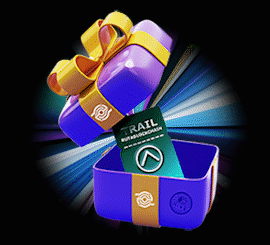Saludos a todos y a la comunidad de @holos-lotus
¿Te imaginas un mundo sin colores, donde los sentidos del olfato, tacto, oído sean el medio de información? Para muchos esta es su realidad cotidiana.
Para quienes me siguen en mis publicaciones, pueden ver que una de las cosas que amo hacer es la labor que realizo como guía con las personas con discapacidad visual.
Desde el año 2018 soy colaboradora, voluntaria y amante de servir como guía a las personas ciegas y uno de mis objetivos es sensibilizar a las personas visuales sobre la importancia de guiar y acompañarlos, saber sobre las técnicas a utilizar en situaciones cotidianas y en ambientes naturales y llevar un mensaje de empatía para que sean parte de las propuestas que se hacen en diferentes actividades y paseos.
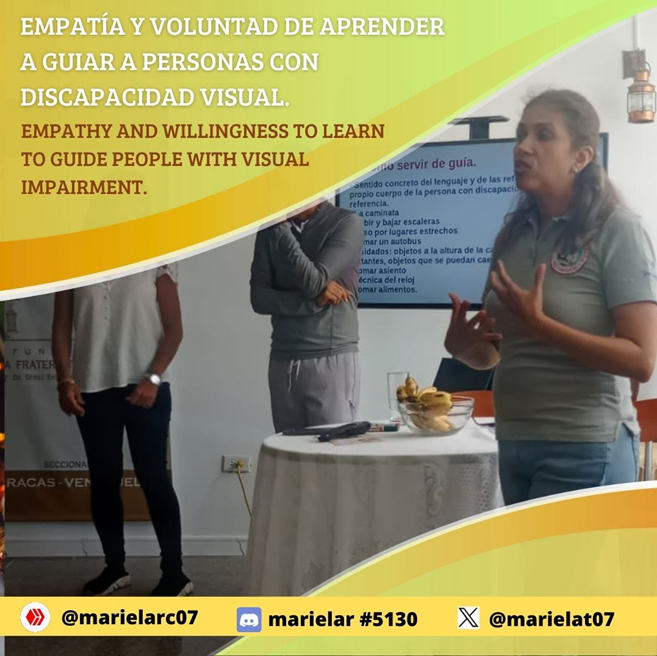
La visión no es una barrera para realizar determinadas labores, ni tampoco para disfrutar de un paseo por la ciudad, la playa o la montaña. Por estas razones hoy quiero compartir con todos ustedes, mi experiencia con talleres formativos, que resaltan lo significativo que es brindar un acompañamiento adecuado para garantizar el disfrute pleno en estos espacios.
Curso teórico – práctico: Formación de voluntarios en guías de montaña para personas con discapacidad visual (febrero año 2019)
Realizado por Asociver Asociación Civil, “Ver desde el alma que busca accesibilidad, inclusión para personas Invidentes” con los Exploradores Karis Caracas, Naturlandia y la Casa de la Cultura David Ferriz en la logística.
Fueron tres días enriquecedores y transformadores, donde compartimos alegría, entusiasmo y conocimientos, desde lo teórico llevado a la vivencia práctica; tres días que nos permitió cambiar la forma de ver el mundo por medio del servicio, la buena voluntad y demostrando que si se pueden hacer muchas cosas.
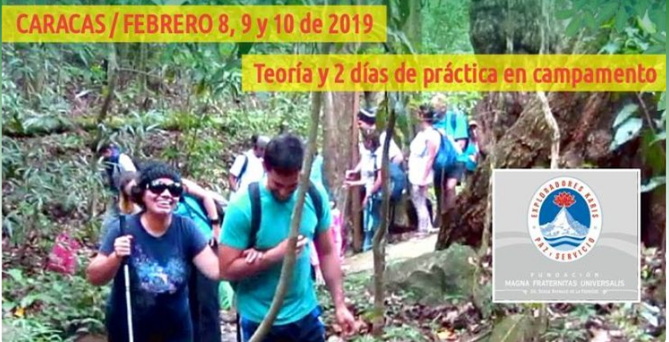
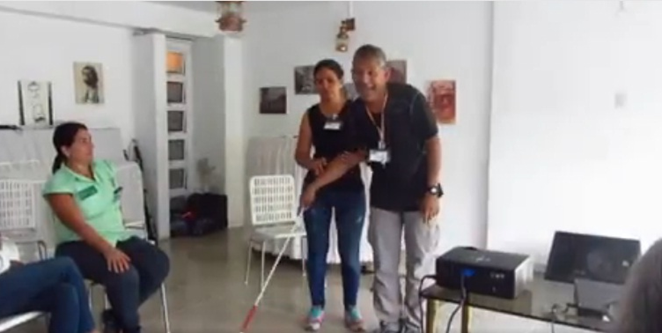
El primer día, en la sede de la Casa de la Cultura, nos entregaron los fundamentos teóricos más relevantes, los dos siguientes días fue la práctica en campamento, donde no solo tuvimos la oportunidad de guiar, sino también tener la experiencia de ser guiados; en lo personal fue un antes y un después, estaba muy asustada, en principio tenía miedo de no ver por dónde iba, eso es instinto de supervivencia. Cuando no veo me doy cuenta que la mirada está en las emociones y en los otros sentidos, ese día aprendí que los pies se vuelen los ojos que te llevan.
Ellos ponen su vida en las manos de sus guías y el aprender de como las personas ciegas interpretan lo que los visuales les dice es importante, es por eso que no todas las personas están capacitados para guiar, no solo es querer, es ser responsables de velar por la seguridad de ellos y la nuestra, no distraernos y sobre todo siempre hablar, describir, contar, escuchar, que la palabra sea una aliada en la experiencia. Esto me ayudo a tener confianza en el otro y en mi misma.
Para eso debemos tomar en cuenta:
✅ En el acompañamiento en Ambientes Naturales, prevalece la estimulación de los sentidos y el bienestar emocional, de allí que la descripción del entorno, la superficie, rocas, hierbas, arena, mar, como también los desniveles, barrancos, raíces de los árboles en fin, posibles peligros de obstáculos naturales, tienen que ser tomados en cuenta.
✅ Hay que permitir la exploración táctil, tocar hojas, abrazar un árbol, sentir una pluma, una roca o el agua, escuchar el canto de los pájaros, el sonido del agua de un rio, los olores de las flores, la tierra húmeda o del mar.
✅ Adaptarse al ritmo del compañero es fundamental, si es necesario hacer paradas, mantener la comunicación constante monitoreando cómo se siente y si necesita algo.
El guía senderista tiene que velar por su seguridad y la del compañero.
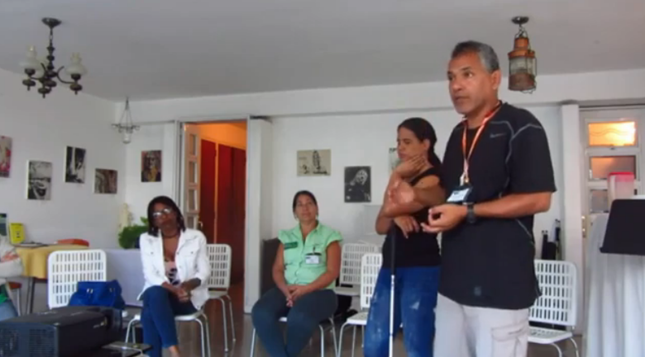

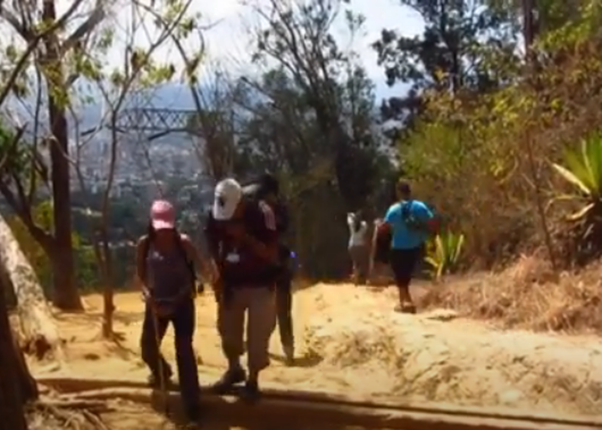
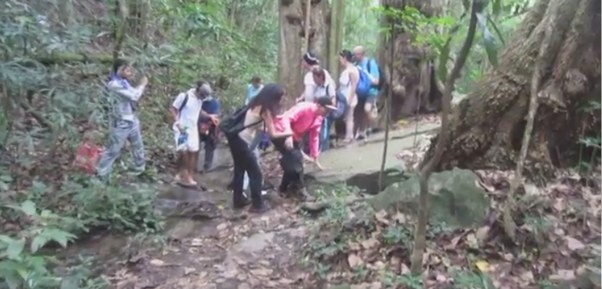
Han sido varias las caminatas y paseos luego de este curso, sin embargo no fue sino hasta el año 2024 cuando retomamos el refrescamiento de estas formaciones. Muchos de los primeros guías ya no están en el país o no tienen las condiciones actualmente para continuar con la labor, por eso era hora de entrenar a una nueva generación.
Taller para guías de personas con discapacidad visual en situaciones cotidianas (julio año 2024)
Esta nueva iniciativa fue promovida por los Exploradores Karis Caracas y efectuado en la sede de la Casa de la Cultura David Ferriz. Esta vez fui invitada a participar como parte del equipo de facilitadores que ese día estarían dictando el taller, junto a la profesora Zharin Herrera de @caidv.capital (Centros de Atención Integral a la Persona con Discapacidad Visual) y el Ing. Federico Zapata por los Karis.
La duración fue de 4 horas y asistieron a la convocatoria 21 participantes entre amigos con discapacidad visual, guías y personas interesadas en aprender. Dentro de la temática se abordaron puntos como las características generales de la discapacidad visual, como servir de guía y otras consideraciones generales.
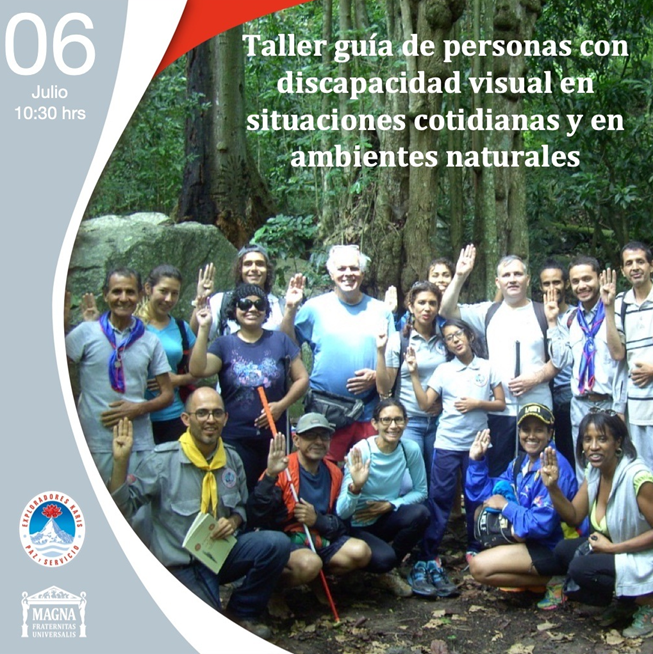
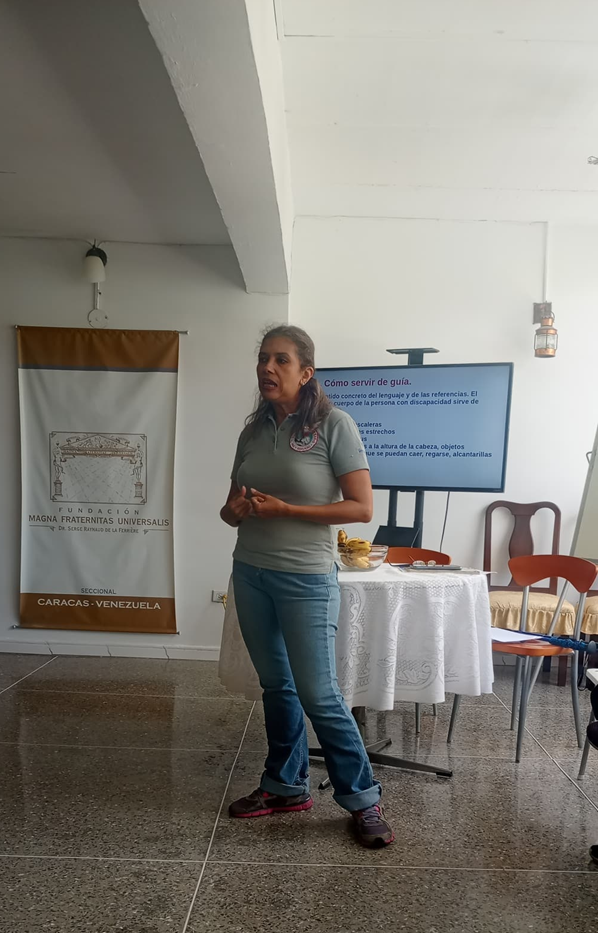
Los guías tenemos que saber las técnicas básicas al momento de acompañar a una persona ciega, es por eso que también tuvimos la participación de los amigos ciegos Wilmer Gomez de @veportimismo_(IG) a Pedro Borges, Fabian Zaraza @fabianencuento (IG) Ana Isabel Rodriguez, Ivan Castillo y Edgar Romero quienes nos aportaron con sus vivencias de manera carismática su perspectiva y pudimos llevar lo teórico a la práctica de primera mano.
Muchos errores que comentemos los mismos guías, en nuestro verbo o porque damos por sentado situaciones de manera inconsciente, pero este tipo de actividades no solo instruyen a nuevos colaboradores, sino que refuerzan a los guías que nos llevan a la reflexión de cómo estamos realizando nuestra labor.
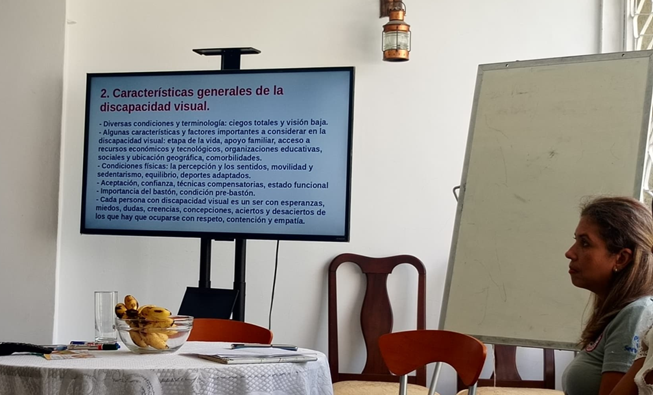

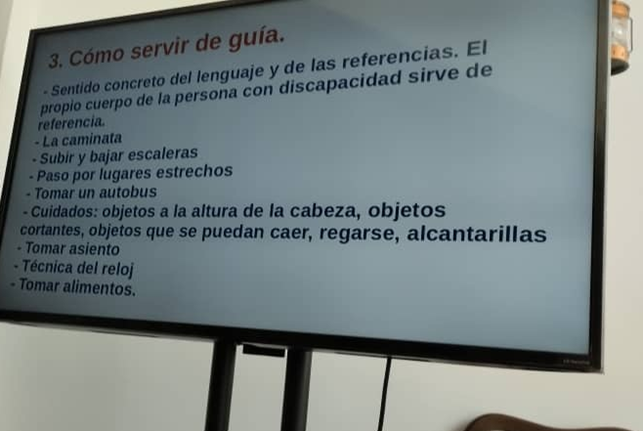
El agarre del brazo para caminar, debe hacerse por encima del codo, y al pasar por lugares estrechos, el guía debe colocar su brazo detrás de la espalda, para que el amigo ciego se coloque detrás del guía.
La descripción del entorno, donde el verbo nos permite ir informando de los obstáculos, cambios de niveles, giros, escaleras, entre otros, de manera anticipada.
Al hablar dirigirnos a ellos, indicarles quien le está hablando y evitar tocarlos primero.
El uso de la terminología precisa, como decir a la derecha, a tu izquierda, adelante, detrás y la técnica del reloj “a las 12” para que se ubique en frente y así sucesivamente a las 3, 6 y 9 y en las escaleras avisar si suben o bajan.
Al sentarlos, guiarlos con la mano para que toque el asiento, ellos mismos buscan de sentarse.
Importante, hablarle con naturalidad y preguntar si requiere de alguna ayuda para no sobreprotegerlos, no quitarles el bastón, tomarlos con fuerza de la mano, describir el lugar espacial por donde se encuentran.
Estar prevenido con los marcos de las puertas y los techos de los autobuses.
Un anécdota fue cuando veníamos por las escaleras de salida del parque y las rejas de la entrada estaban a medias, yo pase con varios de los compañeros sin problema, sin embargo el ultimo era el más alto y no logre advertirle, así que el golpe que se dio en frente todavía, luego de varios años me lo recuerda, ese día fue uno de los ejemplos.
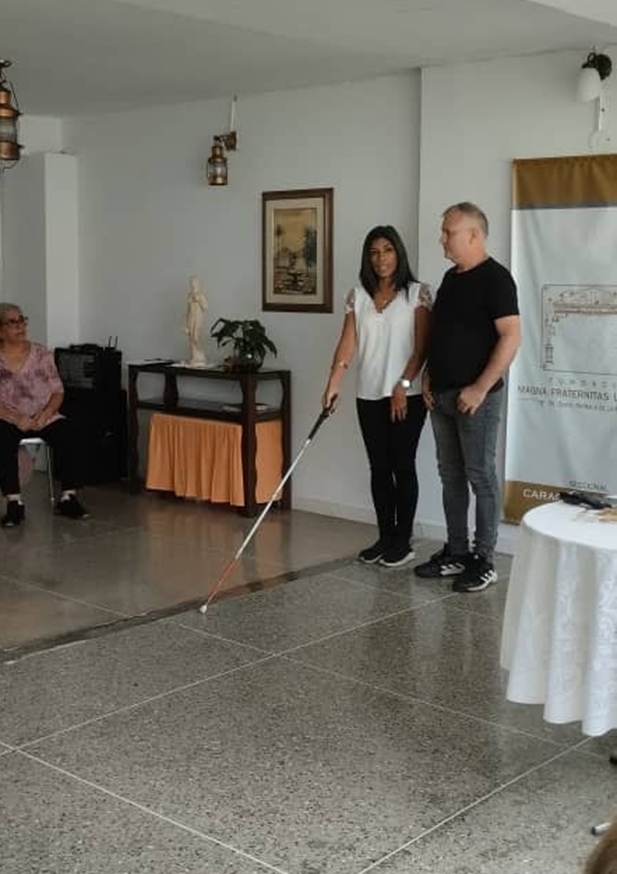
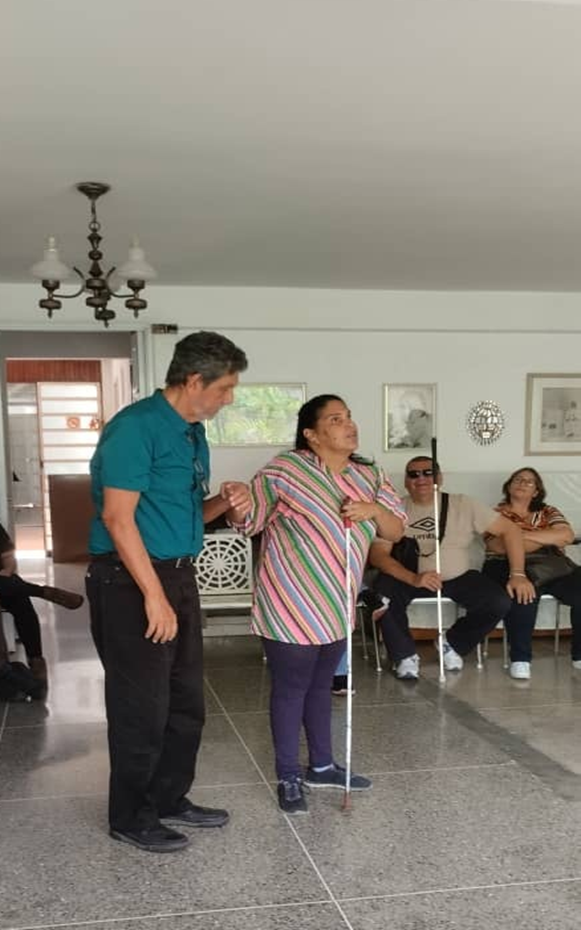
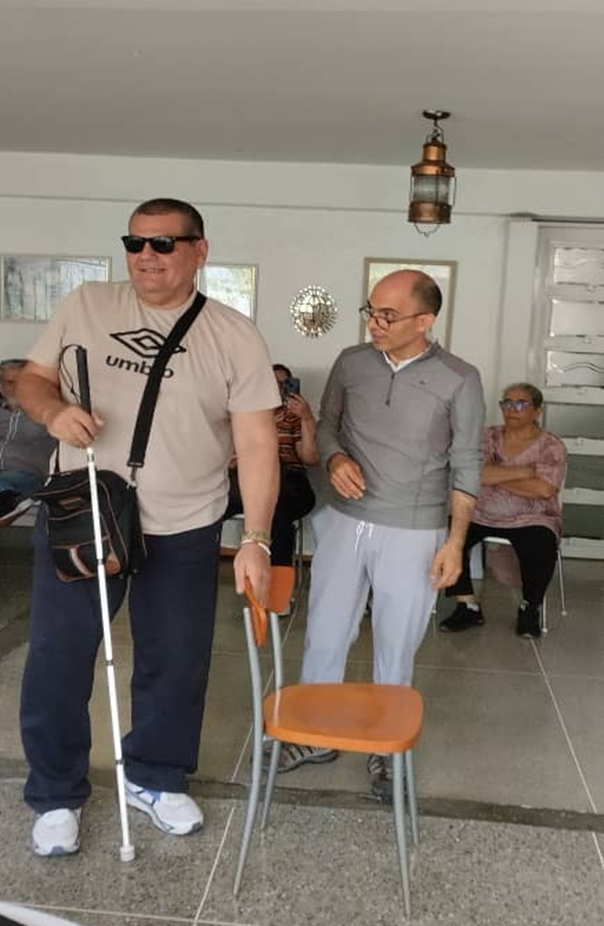
Nuestro propósito es seguir realizando actividades en diferentes lugares, hacer paseos, senderismo en la montaña, charlas, continuar con las sesiones de yoga, biodanza y cualquier otra actividad que requiera de nuestros servicios para construir una sociedad más inclusiva.
Para este año estaremos anunciando la Segunda parte de este Taller, que nos lleva a manejar técnicas descriptivas y de seguridad en los ambientes naturales.
Se parte de nuestro equipo que abre caminos hacia la inclusión y el disfrute pleno para todos.
Les seguiré compartiendo más experiencias en próximas publicaciones, para continuar prestando apoyo y contribuir con los fondos para la compra de bastones y material de trekking.
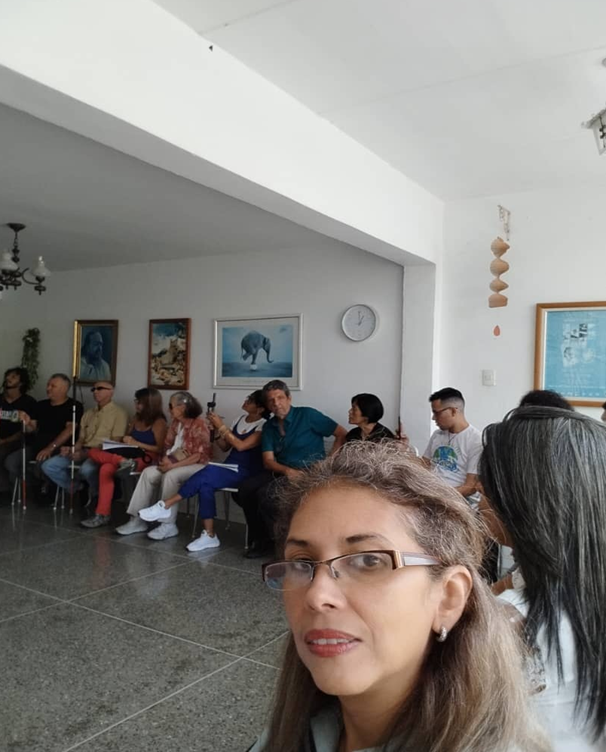


Greetings to all and to the @holos-lotus community.
Can you imagine a world without colors, where the senses of smell, touch and hearing are the means of information? For many this is their daily reality.
For those who follow me in my publications, you can see that one of the things I love to do is the work I do as a guide with visually impaired people.
Since 2018 I am a collaborator, volunteer and lover of serving as a guide to blind people and one of my goals is to raise awareness among visual people about the importance of guiding and accompanying them, to know about the techniques to use in everyday situations and in natural environments and to bring a message of empathy so that they are part of the proposals that are made in different activities and walks.

Vision is not a barrier to perform certain tasks, nor is it a barrier to enjoy a walk in the city, the beach or the mountains. For these reasons today I want to share with all of you, my experience with training workshops, which highlight how important it is to provide adequate support to ensure full enjoyment in these spaces.
Theoretical-practical course: Training of volunteers in mountain guiding for the visually impaired (February 2019)
Carried out by Asociver Asociación Civil, "Seeing from the soul, which seeks accessibility, inclusion for blind people" with the Karis Caracas Explorers, Naturlandia and the Casa de la Cultura David Ferriz in the logistics.
They were three enriching and transforming days, where we shared joy, enthusiasm and knowledge, from theory to practical experience; three days that allowed us to change the way we see the world through service, good will and demonstrating that many things can be done.
They were three enriching and transforming days, where we shared joy, enthusiasm and knowledge, from theory to practical experience; three days that allowed us to change the way we see the world through service, goodwill and demonstrating that many things can be done.


The first day, at the headquarters of the Casa de la Cultura, we were given the most relevant theoretical fundamentals, the next two days was the practice in camp, where we not only had the opportunity to guide, but also to have the experience of being guided; personally it was a before and after, I was very scared, at first I was afraid of not seeing where I was going, that is survival instinct. When I do not see I realize that the look is in the emotions and in the other senses, that day I learned that the feet become the eyes that take you.
They put their lives in the hands of their guides and learning how blind people interpret what the visuals tell them is important, that is why not all people are trained to guide, it is not only wanting, it is to be responsible to ensure their safety and ours, not to be distracted and above all always talk, describe, tell, listen, that the word is an ally in the experience. This helped me to have confidence in the other and in myself.
For that we must take into account:
✅ In the accompaniment in Natural Environments, the stimulation of the senses and emotional well-being prevails, hence the description of the environment, the surface, rocks, grasses, sand, sea, as well as the slopes, ravines, tree roots, in short, possible dangers of natural obstacles, have to be taken into account.
✅ Tactile exploration must be allowed, touching leaves, hugging a tree, feeling a feather, a rock or water, listening to birds singing, the sound of river water, the smells of flowers, wet earth or the sea.
✅ Adapt to the pace of the companion is essential, if necessary make stops, maintain constant communication by monitoring how he feels and if he needs anything.
The trekking guide has to look after his own safety and that of his companion.




There have been several hikes and walks after this course, however it was not until the year 2024 when we resumed the refreshing of these trainings. Many of the first guides are no longer in the country or do not have the conditions to continue the work, so it was time to train a new generation.
Workshop for guides for the visually impaired in everyday situations (July 2024)
This new initiative was promoted by the Karis Caracas Explorers and held at the headquarters of the Casa de la Cultura David Ferriz. This time I was invited to participate as part of the team of facilitators who would be teaching the workshop that day, along with Professor Zharin Herrera from @caidv.capital (Integral Attention Centers for the Visually Impaired) and Federico Zapata for Karis.
The event lasted 4 hours and was attended by 21 participants, including friends with visual impairment, guides and people interested in learning. Within the subject matter, points such as the general characteristics of the visually impaired, how to serve as a guide and other general considerations were addressed.


That is why we also had the participation of blind friends Wilmer Gomez from @veportimismo_(IG), Pedro Borges, Fabian Zaraza @fabianencuento (IG), Ana Isabel Rodriguez, Ivan Castillo and Edgar Romero, who charismatically shared their perspective with us and we were able to put theory into practice first hand.
Many mistakes are made by the guides themselves, in our verb or because we take situations for granted unconsciously, but these types of activities not only instruct new collaborators, but also reinforce the guides that lead us to reflect on how we are doing our work.



In everyday situations there are basic techniques such as:
The arm grip for walking should be above the elbow, and when passing through narrow places, the guide should place his arm behind his back, so that the blind friend is placed behind the guide.
The description of the environment, where the verb allows us to inform of obstacles, changes in levels, turns, stairs, among others, in advance.
When speaking, we should address them, indicate who is speaking to them and avoid touching them first.
The use of precise terminology, such as saying to the right, to your left, forward, behind and the technique of the clock "at 12 o'clock" to be located in front and so on at 3, 6 and 9 o'clock and on the stairs to let them know if they are going up or down.
When seating them, guide them with your hand to touch the seat, they themselves seek to sit down.
It is important to talk to them naturally and ask them if they need any help so as not to overprotect them, do not take away their cane, hold their hand tightly, describe the spatial location where they are.
Be aware of the door frames and roofs of the buses.
An anecdote was when we were coming down the stairs at the exit of the park and the gates of the entrance were halfway, I passed with several of the companions without problem, however the last one was the tallest and I failed to warn him, so the blow he gave himself in front still, after several years he reminds me of it, that day was one of the examples.



Our purpose is to continue to carry out activities in different places, to make walks, hiking in the mountains, talks, continue with yoga sessions, biodance and any other activity that requires our services to build a more inclusive society.
For this year we will be announcing the Second part of this workshop, which leads us to handle descriptive techniques and safety in natural environments.
Be part of our team that opens paths towards inclusion and full enjoyment for all.
I will continue to share more experiences in future publications, to continue to support and contribute to the funds for the purchase of poles and trekking equipment.



• Fotos de mi archivo personal tomadas con mi telefono celular / Photos from my personal archive taken with my cell phone.
•Traducido con www.DeepL.com (versión libre) / Translated with www.DeepL.com (free versión)
• Banner y separadores diseñado en Canva con los elementos disponibles en su versión gratuita / Banner and separators designed in Canva with the elements available in its free version
